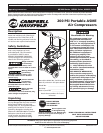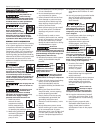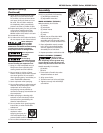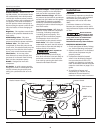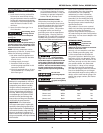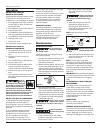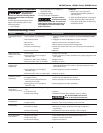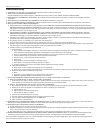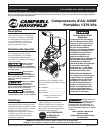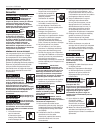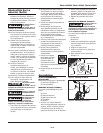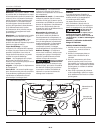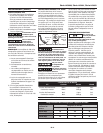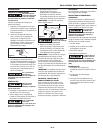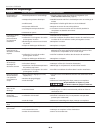
General Safety
CALIFORNIA PROPOSITION 65
This product or its
power cord may
contain chemicals, including lead, known
to the State of California to cause cancer
and birth defects or other reproductive
harm. Wash hands after handling.
You can
create
dust when you cut, sand,
drill or grind materials
such as wood, paint, metal,
concrete, cement, or other masonry. This
dust often contains chemicals known
to cause cancer, birth defects, or other
reproductive harm. Wear protective gear.
GENERAL SAFETY INFORMATION
Air compressors are utilized in a variety
of air system applications. Because air
compressors and other components
(material pump, spray gun, filters,
lubrications, hoses, etc.) used make up
a high pressure pumping system, the
following safety precautions should be
observed at all times. Only persons well
acquainted with these rules of safe
operation should be allowed to use the
air compressor.
Risk of
Bursting! This compressor
is designed to provide air
pressure up to 200 psi. Most
attachments are designed to operate
at a maximum pressure of less than
125 psi. DO NOT adjust the regulator to
result in output pressure greater than
the marked maximum pressure of the
attachment.
Risk of Injury! Do not
direct air stream at
body.
All electrical work
should be done
by a qualified (licensed or certified)
electrician. On a properly wired circuit,
the black wires supply a voltage
potential even when the unit is off.
1. Read instruction
manuals for each
component carefully,
before attempting to
assemble, disassemble
or operate your particular system.
2. Wear safety glasses and
use hearing protection
when operating the
pump or unit.
3. Do not stand on or use the pump or
unit as a handhold.
4. Do not exceed pressure rating of
any component in system.
5. Protect material lines and air lines
from damage or puncture. Keep
hose and power cable away from
sharp objects, chemical spills, oil,
solvents, and wet floors.
6. Never point a spray gun at oneself
or any other person. Accidental
discharge may result in serious
injury.
7. Check hoses for weak or worn
condition, before each use, making
certain all connections are secure;
do not use if deficiency is found.
Notify an authorized service facility
for examination or repair.
Do not run
unattended. Leaving
compressor in ON position may allow it to
turn on inadvertently. To prevent this and
possible damage from power surge, turn
to OFF position after each use.
8. Release all pressures within system
slowly; dust and debris may be
harmful.
Keep
fingers
away from a running
compressor; fast moving
and hot parts will cause
injury and/or burns.
Disconnect power
and depressurize
system before servicing air compressor!
9. Follow all local electrical and safety
codes, as well as the National
Electrical Code (NEC) and the
Occupational Safety and Health Act
(OSHA).
10. Wiring and fuses should follow
electrical codes, current capacity,
and be properly grounded.
11. Electric motors must be securely
and adequately grounded. See
grounding instructions and
extension cord information, in this
manual.
12. Always disconnect power source
before working on or near a motor,
or its connected load. If power
disconnect point is out-of-sight, lock
it in the open position and tag to
prevent unexpected application of
power.
13. Guard all moving parts; keep visitors
away. Never allow children in work
area.
14. Use only a properly grounded outlet
that will accept a three pronged
plug, and wear shoes to prevent
shock hazards.
Be
careful
when touching exterior of
operating motor; it may be
hot enough to cause injury.
Compressor parts may be hot even if the
unit is stopped.
15. Protect power cable from coming in
contact with sharp objects.
16. Clean electrical or electronic
equipment with an approved
cleaning agent, such as dry,
nonflammable cleaning solvent.
Motors,
electrical
equipment and controls can
cause electrical arcs that
will ignite a flammable gas
or vapor. Never operate or repair the
unit near a flammable gas or vapor.
Never store flammable liquids or gases
in the vicinity of the compressor.
17. To reduce fire hazard,
keep engine/motor
exterior free of oil,
solvent, or grease.
18. To avoid spontaneous combustion,
discard waste rags into approved
metal waste cans.
19. NEVER reset safety valve or pressure
switch. Keep safety valve free from
paint and other accumulations.
This provides safety against over
pressure.
Never remove or
attempt to adjust
safety valve. Keep safety valve free
from paint and other accumulations.
20. Do regular maintenance; keep all
nuts, bolts, and screws tight, to be
sure equipment is in safe working
condition .
21. Keep cleaning rags and other
flammable waste materials in a
tightly closed metal container
and dispose of later in the proper
fashion.
MANUAL
2
Operating Instructions
www.chpower.com



